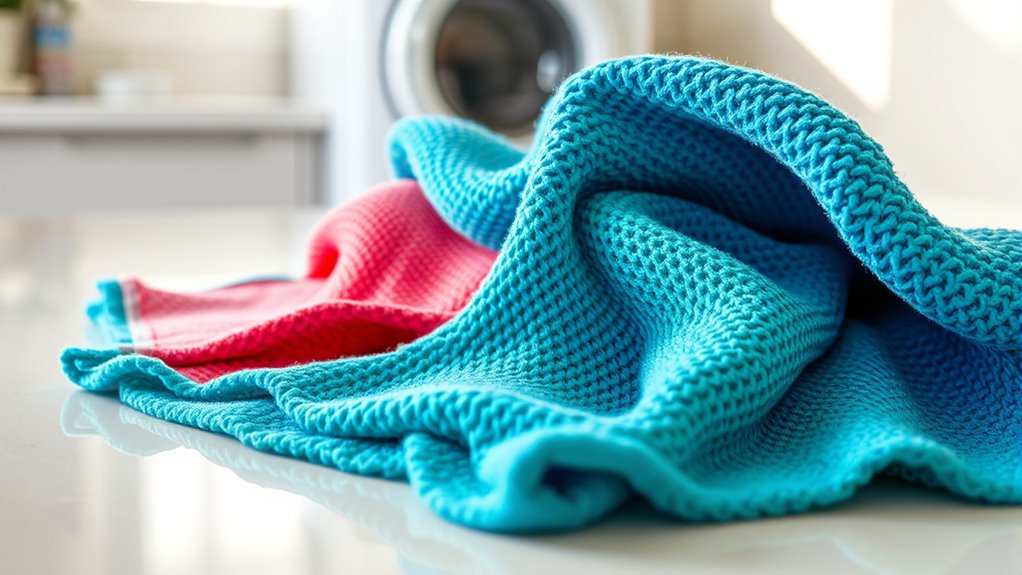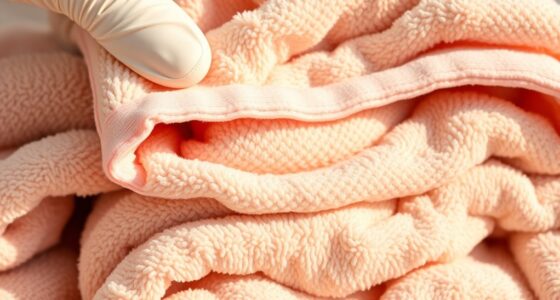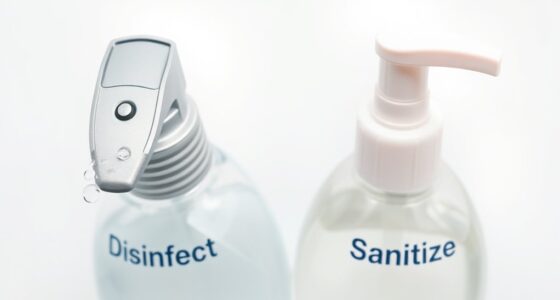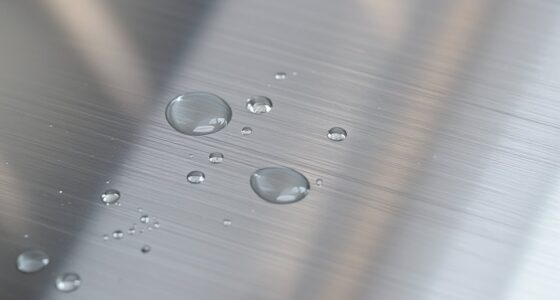To keep your microfiber cloths effective, wash them with eco-friendly detergents in cold water on a gentle cycle, avoiding fabric softeners and bleach. Store them in a dry, clean spot and dry thoroughly to prevent mold. Watch for signs like fraying, lingering odors, or reduced cleaning power—time to retire them when fibers break down. Staying attentive guarantees your cloths last longer, and if you stick around, you’ll discover even more tips to maximize their lifespan.
Key Takeaways
- Regularly wash microfiber cloths with eco-friendly detergents on gentle cycles to maintain their cleaning effectiveness.
- Avoid fabric softeners and bleach, which can damage fibers and reduce performance.
- Store in a dry, clean environment and dry thoroughly to prevent mold and fiber degradation.
- Inspect for fraying, tears, or persistent odors; replace when fibers become worn or ineffective.
- Proper maintenance and timely replacement extend microfiber lifespan and ensure optimal cleaning results.
Understanding the Unique Benefits of Microfiber Cloths
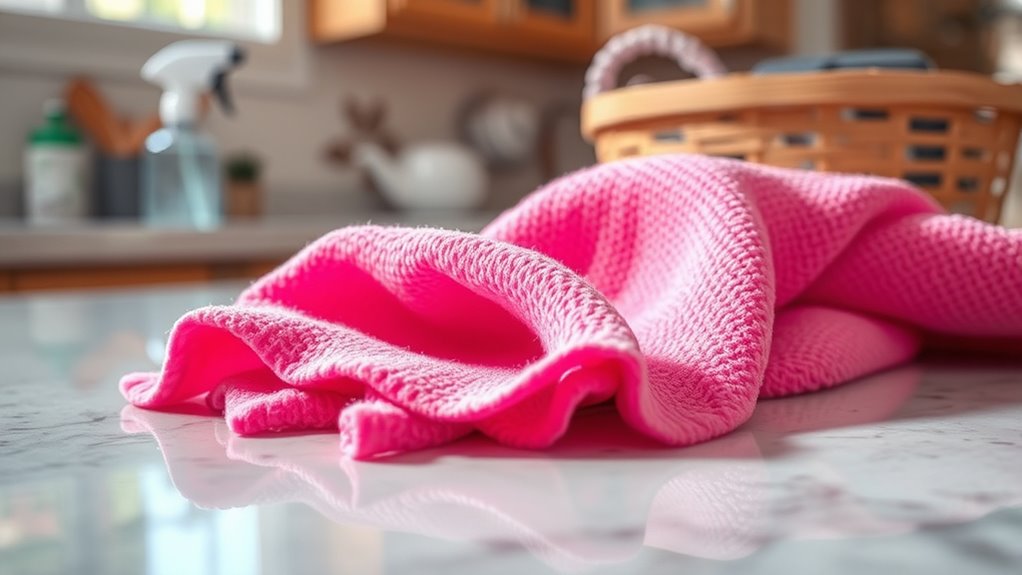
Microfiber cloths offer several distinct advantages that make them a popular choice for cleaning. One major benefit is their eco-friendly cleaning capability—you can use less chemical cleaners because microfiber traps dirt, dust, and bacteria more effectively. This eco-friendly cleaning approach not only reduces chemical runoff but also minimizes your environmental impact. Additionally, microfiber is excellent for allergen removal; it captures tiny particles like pollen, pet dander, and dust mites, helping improve indoor air quality. You’ll find microfiber ideal for sensitive environments, especially if you suffer from allergies. Its fine fibers create a powerful physical barrier that lifts and holds onto debris without harsh scrubbing. Overall, microfiber cloths provide a sustainable, efficient, and allergen-conscious way to keep your home clean and fresh.
Proper Washing Techniques to Preserve Effectiveness
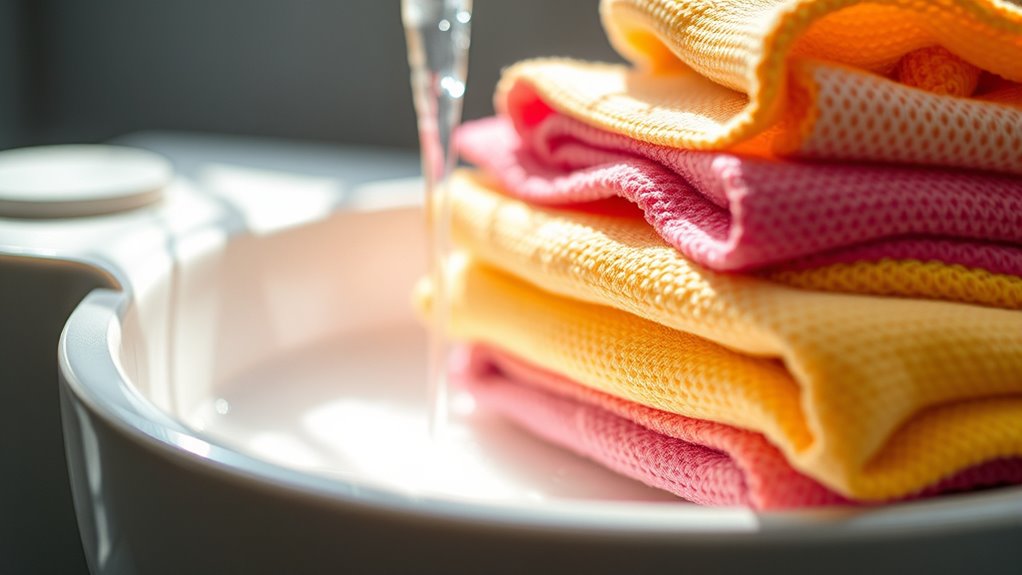
To keep microfiber cloths working at their best, proper washing techniques are key. Always choose eco friendly detergents to avoid residue buildup that can reduce their effectiveness. Use gentle machine wash settings, such as delicate or cold water cycles, to prevent fibers from breaking down. Avoid fabric softeners and bleach, which can coat the fibers and diminish their cleaning ability. Wash microfiber cloths separately from other laundry to prevent lint transfer. Rinse thoroughly to remove any detergent residue, which can clog the fibers. Dry your cloths by air drying or using a low heat setting in the dryer. Proper washing preserves the cloths’ softness, absorbency, and durability, ensuring they perform ideally with every use. Additionally, understanding the benefits of microfiber cleaning can motivate proper care and maintenance routines.
Avoiding Common Mistakes That Damage Microfiber Fabrics
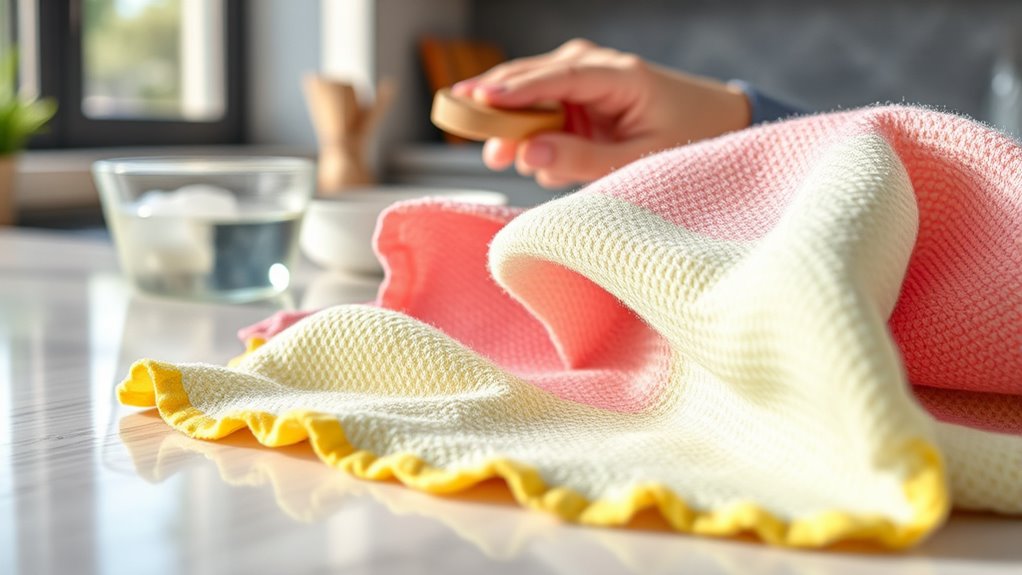
Even when you take care to wash microfiber fabrics properly, certain mistakes can still cause damage. One common error is leaving chemical residues on the cloths, which can weaken the fibers and reduce their effectiveness. Always rinse thoroughly to remove detergents and avoid fabric softeners, as these can leave residues that clog the fibers. Additionally, improper storage can harm your microfiber cloths; storing them in damp or dirty environments encourages bacteria growth and degrades the fabric’s quality over time. Keep your cloths clean and dry, and store them in a cool, dry place away from direct sunlight. Avoid folding or stuffing them into tight spaces that can cause creases or damage. Staying mindful of these mistakes helps extend the life of your microfiber cloths. Incorporating sound science about material durability can further inform proper care practices.
Best Practices for Drying and Storing Your Cloths
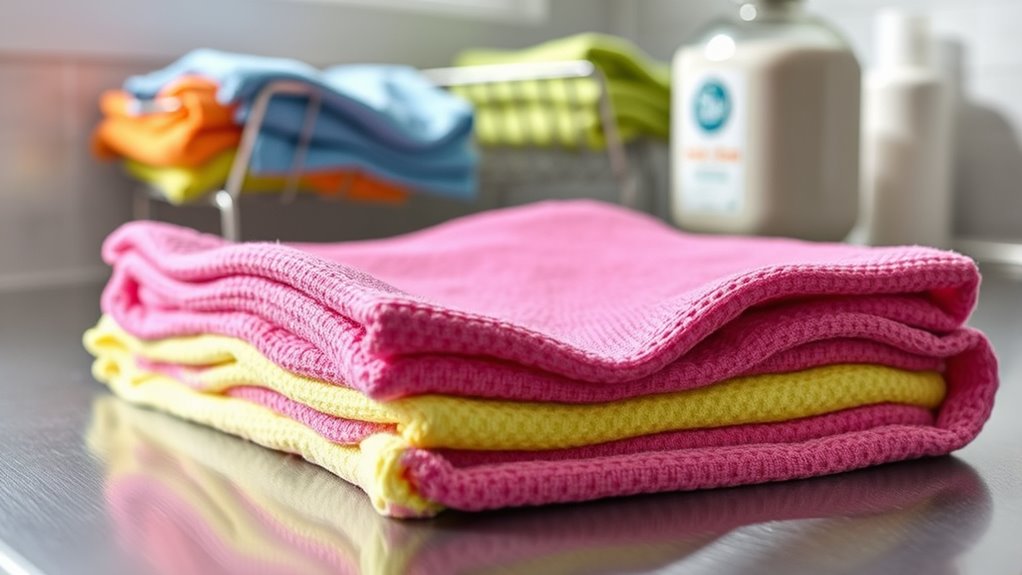
Proper drying and storage are key to maintaining your microfiber cloths’ effectiveness and longevity. To guarantee they stay in top shape, use proper storage tips like keeping cloths in a clean, dry place away from direct sunlight, which can degrade fibers. When drying, opt for air drying or tumble drying on low heat; avoid high heat that can damage the fabric. Always wash and dry your cloths thoroughly before storing to prevent mold and bacteria buildup. Fold or roll them neatly to prevent creases and tangling. Keep them separate from other cleaning tools to avoid lint transfer. Proper drying techniques and thoughtful storage will extend your microfiber cloths’ lifespan and keep them ready for any cleaning task.
Recognizing Signs of Wear and When to Replace
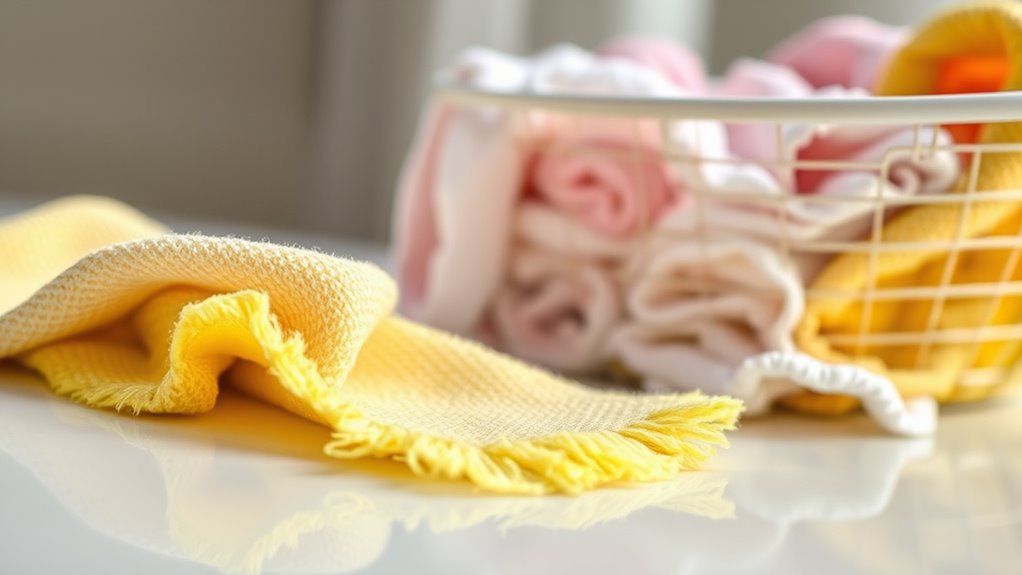
If your microfiber cloth shows fraying or tears, it’s a clear sign it’s time to replace it. Persistent odors or stains that won’t come out suggest the cloth’s cleaning power has diminished. Recognizing these signs helps guarantee you’re using effective and hygienic cleaning tools.
Visible Fraying or Tears
Visible fraying or tears are clear signs that your microfiber cloth has reached the end of its useful life. When you notice frayed edges or torn fibers, it’s time to replace the cloth to maintain cleaning effectiveness. Damaged areas can trap dirt and bacteria, making your cloth less hygienic. Keep an eye out for the following signs:
- Frayed edges that unravel easily during use
- Torn fibers that create small holes or rips
- Worn spots where the fabric appears thinned or ragged
These indicators show the cloth can no longer perform properly. Continuing to use a worn microfiber cloth can spread dirt rather than clean it. Replacing it ensures your cleaning efforts stay effective and hygienic. Regular inspection helps prevent filter clogging and maintains overall cleaning efficiency.
Persistent Odor or Stains
When your microfiber cloth starts to retain persistent odors or develop stubborn stains despite regular washing, it’s a clear sign that the fabric may be worn out. Odor removal becomes difficult, and stains resist stain treatment efforts. If odors linger after thorough cleaning, or stains remain visible, it indicates the cloth’s fibers are breaking down, reducing its effectiveness. Repeated washing may no longer restore freshness or cleanliness. At this point, it’s time to replace the cloth to maintain hygienic standards and cleaning efficiency. Continuing to use worn-out microfiber cloths can spread bacteria or dirt rather than remove them. Recognizing these signs helps you avoid ineffective cleaning and ensures your surfaces stay truly clean and odor-free. When in doubt, replace your microfiber cloth to keep your cleaning routine effective. Notably, the decline in cleaning power is often linked to the breakdown of fibers, which can be understood through fiber degradation studies in textile science.
Tips for Extending the Lifespan of Your Microfiber Towels
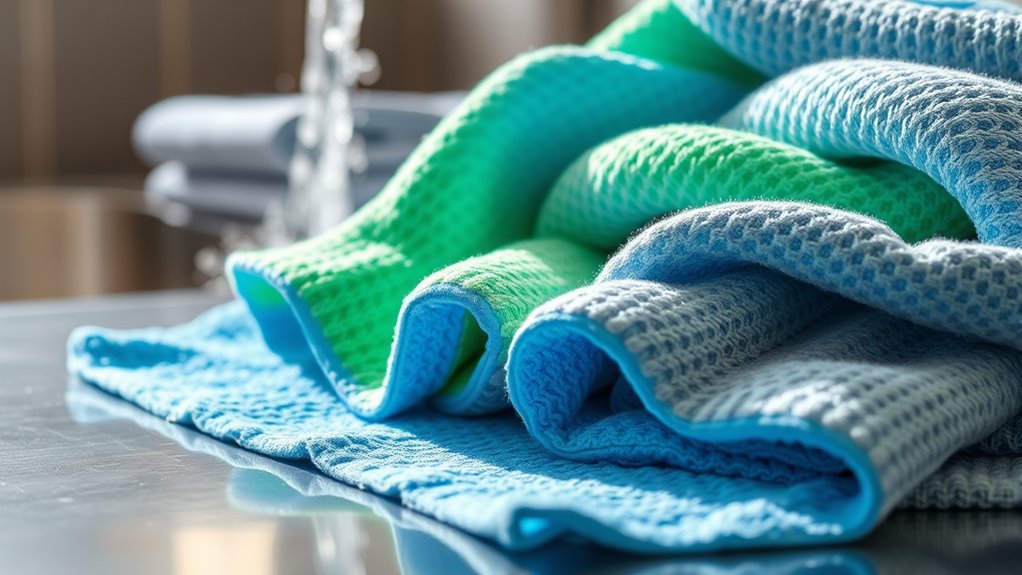
To make your microfiber towels last longer, proper handling and care from the beginning are vital. Follow microfiber cleaning tips like avoiding fabric softeners and high heat, which can damage the fibers. Using eco friendly microfiber use practices, such as washing with mild detergents, helps preserve their integrity. Additionally, understanding proper storage methods prevents unnecessary stress on the fibers and prolongs their usability microfiber maintenance.
To extend their lifespan:
- Wash towels separately to prevent lint transfer and maintain effectiveness
- Air dry or use a low heat setting to avoid fiber degradation
- Avoid bleach and fabric softeners, which weaken microfiber structure
These simple steps ensure your towels stay durable and effective longer. Proper care not only saves money but also supports eco-friendly use by reducing waste and energy consumption.
Sustainable and Cost-Effective Microfiber Maintenance
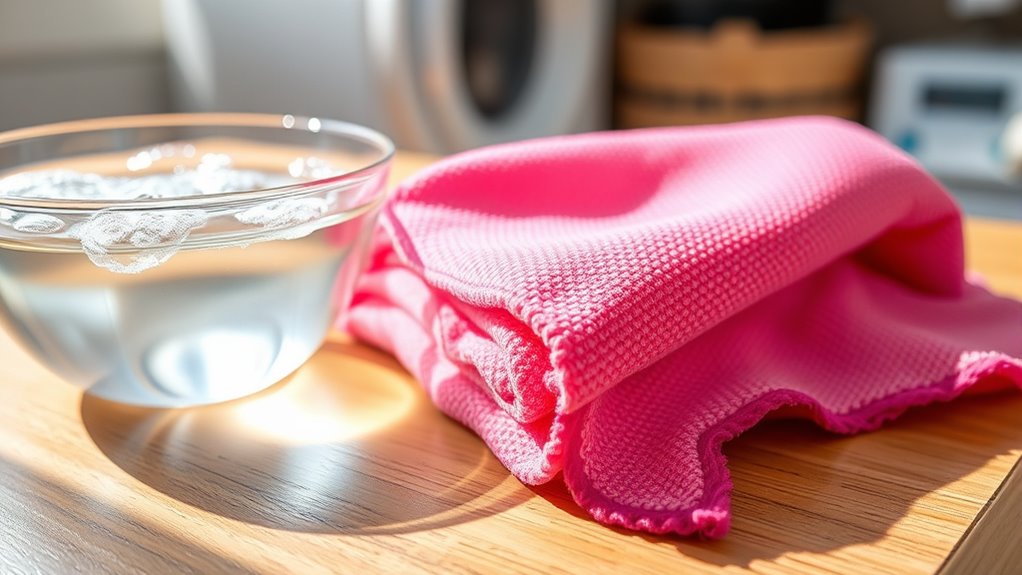
Adopting sustainable and cost-effective microfiber maintenance starts with mindful washing habits that extend the lifespan of your towels. Using cold water and avoiding fabric softeners reduces environmental impact and prevents microfiber degradation. This approach minimizes chemical use and saves money. To make it clearer, here’s a quick comparison:
| Tip | Benefit |
|---|---|
| Wash in cold water | Saves energy and extends microfiber life |
| Skip fabric softeners | Maintains microfiber effectiveness |
| Use DIY cleaning solutions | Reduces chemicals and costs |
Additionally, being aware of Silly family photoshoot fails can remind you to keep things light and fun during chores, making maintenance more enjoyable.
Frequently Asked Questions
Can Microfiber Cloths Be Used on Delicate Electronic Screens Safely?
Yes, microfiber cloths are safe for delicate electronic screens because they offer excellent screen safety and microfiber compatibility. You should use a clean, dry microfiber cloth to gently wipe your screen without applying excessive pressure. Avoid using harsh chemicals or abrasive materials, as these can damage the screen. When choosing a microfiber cloth, make sure it’s designed for electronics to maintain peak cleanliness and prevent scratches.
How Often Should I Replace Microfiber Cloths for Optimal Performance?
You should replace your microfiber cloths every few months for peak performance, as their cloth lifespan diminishes rapidly with use. If you ignore this, you risk cleaning with a cloth so worn out it’s practically useless—like wiping your screens with a rag full of dust! Regular replacement ensures maximum microfiber magic, keeping your screens spotless and scratch-free. Don’t wait until it’s too late—swap out your cloths often to maintain the best cleaning results.
Are There Specific Detergents That Damage Microfiber Fabrics?
You should avoid using harsh detergents with strong chemicals, as they can damage microfiber fabrics. Look for detergent compatibility with microfiber to prevent degradation. Also, steer clear of fabric softener effects; they can leave a residue that reduces the cloth’s effectiveness. Instead, opt for gentle, mild detergents designed for delicate fabrics, and always rinse thoroughly to keep your microfiber cloths in top shape.
Can I Use Fabric Softeners When Washing Microfiber Cloths?
Using fabric softeners on microfiber cloths is like coating a sponge with grease; it hampers their ability to trap dust and dirt. Fabric softener effects can break down microfiber fabric integrity over time, reducing their effectiveness. Instead, stick to mild detergents. This preserves the cloth’s structure, ensuring it continues to work like a magnet for dirt, keeping your cleaning routine efficient and the cloths lasting longer.
What Environmental Impacts Are Associated With Microfiber Cloth Disposal?
When you dispose of microfiber cloths, you contribute to microfiber pollution, which harms aquatic life and pollutes water sources. To reduce this impact, consider recycling microfiber whenever possible. Proper disposal methods, like recycling programs, help limit microfiber pollution and keep plastics out of the environment. By being mindful of how you discard microfiber cloths, you support eco-friendly practices and reduce long-term environmental harm.
Conclusion
By caring for your microfiber cloths properly, you reveal their true magic—like a secret garden that blooms anew. Keep them clean, dry, and replaced when needed, and they’ll serve you faithfully, saving money and the planet. Remember, every stitch and wash is a small act of kindness to your tools and the environment. So, treat your microfiber treasures with love, and they’ll reward you with sparkling results every time—turning routine into a ritual of renewal.
